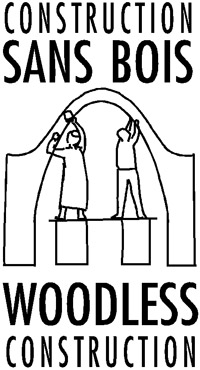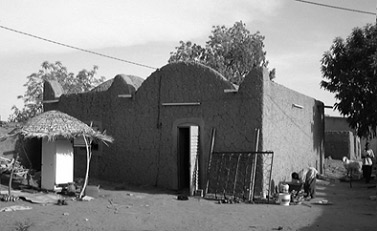| home |
Burkina Faso
Awards


World Habitat Award 1998
The World Habitat Award 1998 was presented by the Building and Social Housing Foundation (BSHF) to DWF for its role in the ‘Promotion of Woodless Construction in Burkina Faso, Mali and Niger’.
Woodless Construction is the name used in the Sahel countries of West Africa for the construction of vault and dome roofed buildings using hand moulded mud bricks. DW has promoted adaptation of the techniques and development of the training process to suit the needs of Sahel builders and people.
Woodless construction :
- Protects the environment and saves wood
- Develops both local skills through training, and income generation opportunities
- Improves living conditions and infrastructure for local families and communities
- Provides a sustainable technique to meet growing shelter needs with scarce resources

Spontaneous house construction by trained builders in Niger
using local available earth bricks.
UN Habitat Scroll of Honour awarded to the Niger Government, Ministry of Construction
Woodless Construction Project Niger 1992
For promoting woodless building techniques based on earth vault and domed roof construction and undertaking training programmes thus serving as a model for sub-Saharan countries lacking wood resources.
Best Practice Database on improving the Living Environment UNCHS & The Together Foundation.
http://database.bestpractices.org

Best Practice Database Summary
Woodless construction addresses shelter and environment problems in the Sahel. Drought and over consumption of wood have depleted organic resources, and methods for achieving shelter have to change.
"Woodless construction" - earth vault and dome roofing - was introduced into the Sahel in 1980 by Development Workshop. The techniques originate in the Middle-East.
Local adaptation and training of builders and local 'builder-trainers' has led to popular adoption of these building techniques, using familiar hand-moulded earth bricks. Woodless construction is affordable and reduces timber depletion and environmental degradation. All the structure is made of local materials. The buildings are strong and durable. The technology suits formal and informal sectors : hospitals, mosques and offices as well as simple shelters and houses.
Over 1,000 woodless buildings are recorded, and many more exist. The process is labour intensive and provides employment for many. A majority of masons now work for their own clients.
The average labour cost for a small village house is about $110. Family labour can reduce costs further. Village masons are often paid in kind especially by their extended family. In urban areas costs increase as materials, transport and labour are paid for.
Woodless construction makes a real difference to some of the poorest people in the world. It encourages self respect, self-help, provides employment and income generation opportunities as well as a low cost housing solution in the many areas around the world that are facing an increasing shortage of timber. For families who live and work in these buildings, woodless construction means a better environment.